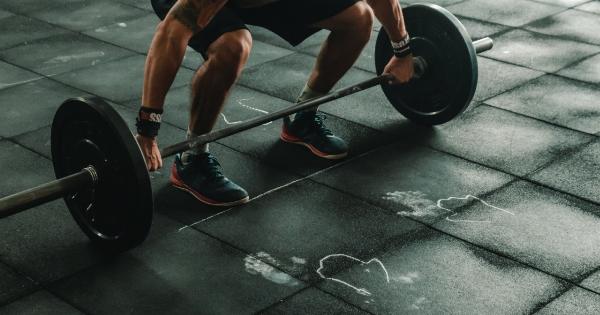High-Intensity Interval Training (HIIT) has gained significant popularity in recent years, and for a good reason. This form of exercise offers a multitude of benefits and is particularly effective for building endurance.
Whether you are an athlete aiming to improve your performance or an individual looking to enhance your fitness level, HIIT can be a game-changer. In this article, we will explore the power of HIIT and how it can help you boost your endurance.
What is HIIT?
HIIT is a training technique that involves intense bursts of exercise followed by short recovery periods. The cycle of intense exertion and brief rest is repeated throughout the training session.
The workouts typically last anywhere from 10 to 30 minutes, making them highly efficient and time-saving.
How Does HIIT Improve Endurance?
1. Boosts Cardiovascular Fitness:.
HIIT is known for its exceptional ability to improve cardiovascular fitness. The intense periods of exercise push your heart rate up, forcing your cardiovascular system to adapt and become more efficient.
Over time, this leads to increased endurance and stamina.
2. Enhances Oxygen Utilization:.
During HIIT, your body demands a significant amount of oxygen to fuel the intense bursts of exercise. This increased demand forces your body to optimize its oxygen utilization, improving your aerobic capacity.
By enhancing your body’s ability to utilize oxygen, HIIT helps you perform better and for longer durations.
3. Increases Mitochondrial Function:.
Mitochondria are the powerhouse of your cells and are responsible for producing energy. The more efficient your mitochondria are, the better your endurance.
HIIT has been found to increase mitochondrial content and function, allowing your body to generate energy more efficiently and sustain exercise for extended periods.
4. Trains Fast-Twitch Muscle Fibers:.
HIIT workouts primarily target fast-twitch muscle fibers, which are important for explosive movements and high-intensity activities. By regularly engaging these muscle fibers, you can improve their endurance and delay the onset of fatigue.
This directly translates into improved overall endurance.
5. Raises Lactate Threshold:.
Lactate threshold refers to the point at which your body can no longer efficiently clear lactate, resulting in a decline in performance.
HIIT training helps raise your lactate threshold, enabling you to perform at a higher intensity for longer durations before fatigue sets in. This allows you to build endurance and delay the onset of exhaustion.
How to Incorporate HIIT into Your Training
Now that you understand the benefits of HIIT for building endurance, it’s time to learn how to incorporate it into your training routine. Here are some key considerations:.
1. Start Slow:.
If you are new to HIIT, it’s essential to start slow and gradually increase the intensity of your workouts. Begin with shorter intervals and longer recovery periods, allowing your body to adapt to the demands of this training style.
2. Choose Suitable Exercises:.
Select exercises that activate multiple muscle groups and mimic the type of activity you want to improve your endurance for. This could include variations of running, cycling, burpees, jump squats, and more.
Ensure proper form and technique to prevent injuries.
3. Determine Work and Rest Ratios:.
Experiment with different work-to-rest ratios to find the ideal combination for your goals. For example, a 1:2 ratio would involve 30 seconds of intense exercise followed by 1 minute of rest.
As you progress, you can decrease the rest periods or increase the work intervals to further challenge yourself.
4. Gradually Increase Intensity:.
As your endurance improves, gradually increase the intensity of your HIIT workouts. This can be achieved by increasing the speed, resistance, or duration of your exercise intervals. Always listen to your body and avoid overexertion to prevent injuries.
5. Mix Up Your Routine:.
Keep your workouts fresh and prevent plateaus by regularly changing the exercises and intervals in your HIIT sessions. This will challenge your body in different ways and target various muscle groups, leading to well-rounded endurance development.
6. Allow for Rest and Recovery:.
HIIT places significant stress on your body, so it is crucial to allow for adequate rest and recovery between sessions. Overtraining can lead to injuries and hinder your progress.
Aim for 2-3 HIIT workouts per week and complement them with other forms of exercise and active rest days.
The Key Benefits of HIIT for Endurance
HIIT offers numerous benefits for building endurance:.
1. Time Efficiency: HIIT workouts are short but highly effective, making them a great option for individuals with busy schedules. You can achieve significant endurance gains in a fraction of the time compared to traditional steady-state cardio exercises.
2. Increased Caloric Burn: Due to the high intensity of the workouts, HIIT helps burn more calories both during and after the training session. This can be beneficial for weight management and overall fitness.
3. Continued Caloric Expenditure: HIIT elevates your metabolic rate, leading to an increased calorie burn for several hours post-workout. This is known as the afterburn effect or excess post-exercise oxygen consumption (EPOC).
4. Versatility: HIIT workouts can be performed using various exercise modalities, making them adaptable to different preferences and fitness levels.
Whether you prefer running, cycling, bodyweight exercises, or equipment-based workouts, you can incorporate HIIT into your routine.
5. Progress Tracking: The interval structure of HIIT allows you to track your progress easily. You can set benchmarks based on the number of repetitions, duration, or intensity level, and strive to improve over time.
This sense of accomplishment can enhance motivation and adherence to your endurance-building journey.
Precautions and Considerations
While HIIT can be an excellent tool for building endurance, it’s essential to consider the following precautions:.
1. Existing Health Conditions: If you have any pre-existing health conditions, such as cardiovascular issues or joint problems, it is crucial to consult with your healthcare provider before beginning HIIT.
They can provide guidance based on your specific needs and help you determine if HIIT is suitable for you.
2. Proper Warm-up and Cool-down: Prior to any high-intensity workout, it is important to properly warm up your muscles and prepare your body for the exertion.
Additionally, don’t forget to cool down and stretch afterward to prevent muscle soreness and promote recovery.
3. Gradual Progression: As with any form of exercise, it’s essential to progress gradually and avoid sudden, significant increases in intensity or volume. This will allow your body to adapt and minimize the risk of injuries or overtraining.
4. Listening to Your Body: While the intensity of HIIT is meant to challenge you, it is important to listen to your body and adapt the workouts as needed.
If you experience pain, dizziness, or excessive fatigue, it’s crucial to scale back and rest as necessary.
Conclusion
HIIT is a powerful training method that can significantly improve your endurance and fitness level.
By incorporating short but intense bursts of exercise followed by recovery periods, you can boost your cardiovascular fitness, enhance oxygen utilization, increase mitochondrial function, train fast-twitch muscle fibers, and raise your lactate threshold. With consistency and proper progression, HIIT can help you achieve your endurance goals efficiently and effectively.



























